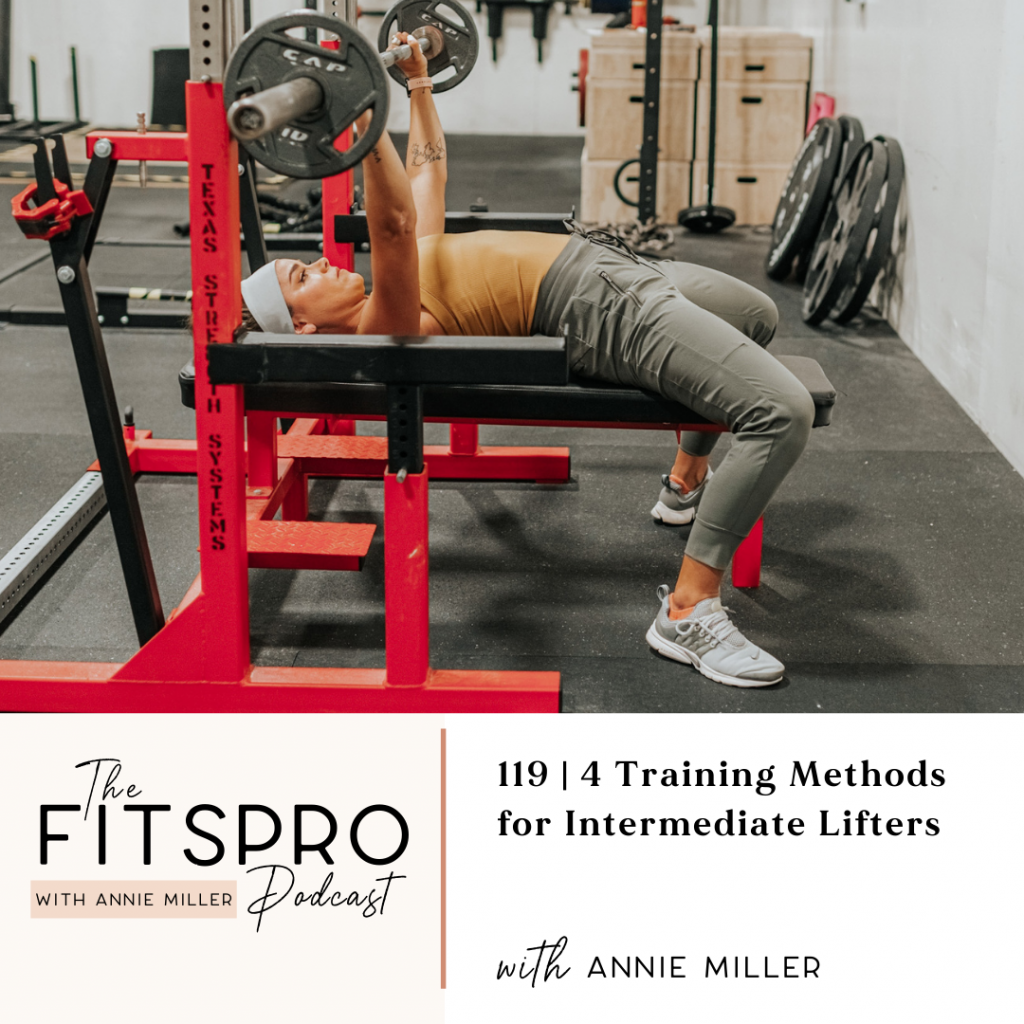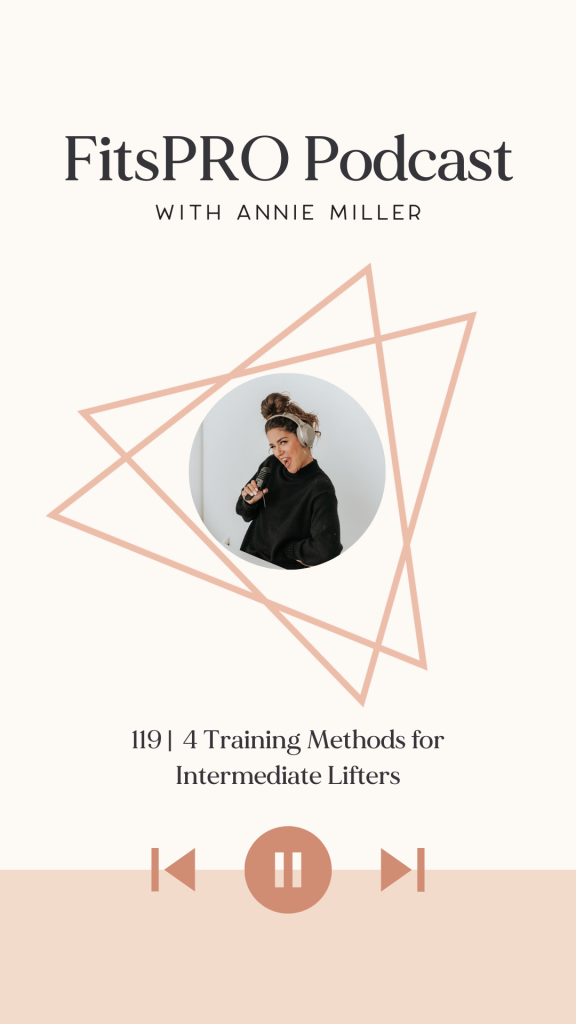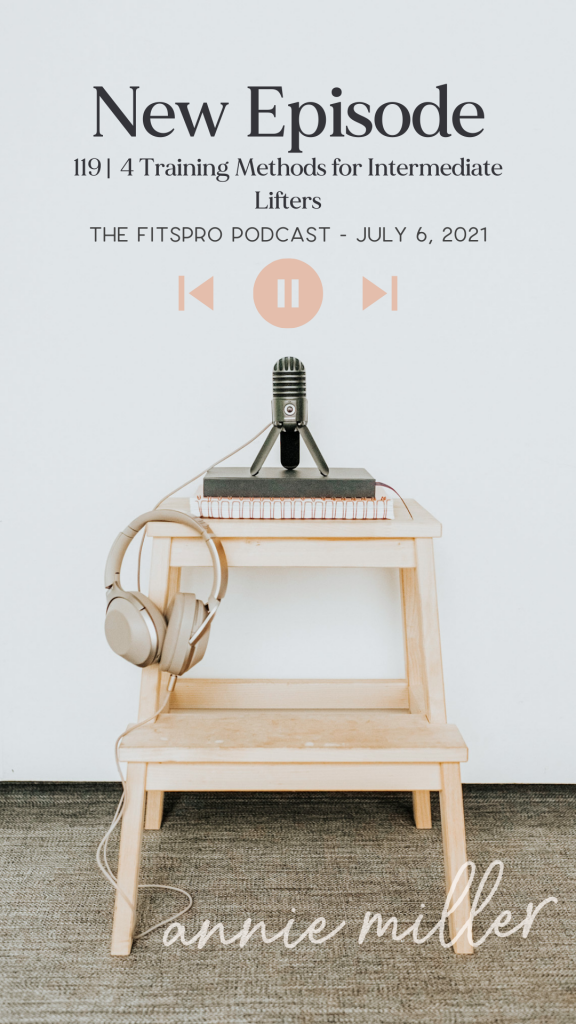the blog
welcome to
looking for something specific? find it here
Podcast: Play in new window | Download (Duration: 31:21 — 43.2MB)
Subscribe: Google Podcasts | RSS

Sharing 4 training methods for intermediate lifters!
Once a lifter has gone through a few bouts of linear progression, what’s next?
They’ve got a 1-3 training years under their belt. They’re familiar with different exercise variations, tempos and working with percentages or RPE. Do they just keep repeating the same linear progressions? Or hop to a new program?
In today’s episode, I hope to give coaches and maybe even trainees some ideas to research and/or implement into their programming. Maybe you already know of these training methods, maybe you don’t. I won’t simply be listing them off, but giving insight into how one would apply these methods into an entire program – including accessory work.
Before we get started, please be reminded that I am not your movement or programming bible. These training methods are tried and tested – like through scientific studies, not just “tried and tested” anecdotally by humans. Take what makes sense for you, ponder it, and stay curious.
Now, I use bits of all of these throughout my 36 total phases of programming inside Built By Annie. Thus, I am partial to them. I just think they are solid training methods to introduce to intermediate lifters. Call me biased, because I am in this sense.
First up!
Conjugate training method or Daily undulating periodization (aka DUP)
I was first introduced to this approach via my chiropractor as we rehabbed my back injury (which happened during squatting). Yes, my back rehab involved squatting three times per week. So, let’s get into it.
The daily undulating periodization is a type of conjugate method. If you read the definition of both from multiple textbooks or the interweb, you might be like…so these are the same thing?
- Conjugate method: Repeating the big lifts multiple times per week, in slightly different ways
- DUP: Changing the volume, rep scheme, intensity of main lifts daily rather than phase to phase.
Same same, yes? For the sake of this episode, yes. Also, I am unsure who FIRST brought DUP to the table, but I know Poliquin has talked extensively about undulating periodizations in general. And though we’re talking about DUP, undulating periodization is also widely used in a weekly fashion – which will make more sense in a second.
In a traditional and even non-traditional linear periodization you might see:
- Monday – Bench
- Tuesday – Squat
- Wednesday – Rest
- Thursday – Overhead Press
- Friday – Deadlift
You could have many other set ups, but the point here is that you’re hitting each big lift ONCE per week, and changing sets and reps, or other factors of said big lifts on a 4-5 week basis. Performing each lift once per week.
With conjugate or DUP, the big lifts are performed three days per week (this is most common from my understanding). That is also *most* common with the big three powerlifting movements of Squat, Bench, and Deadlift. If, like me, you also add overhead press, you simply juggle a bit more, or maybe only hit OH twice per week.
TECHNICALLY – astrix all over here…You could use a DUP for ONE movement pattern which is a weak link in your training. For instance, squatting three days a week if your squat is seriously lacking. Or benching three days per week if you need to bring up your bench.
So how do you hit one, or all big lifts three days per week and not destroy yourself? Fair question.
Rather than having a “power phase” a “strength phase” and a “hypertrophy phase” you do each of those, once per week, for each week.
Are you tracking?
It might look like this for ONE LIFT:
- 4×10 back squat for hypertrophy focus day
- 6×2 back squat for power focus day
- 3×5 back squat for strength focus day
In the weekly fashion of undulating periodization, you’d have a week of 10’s, week of 2’s and week of 5’s say. That could also be 8’s, 5’s and 3’s or what have you.
If you apply DUP to all big lifts, it might look like:
- Bench + Squat – Day 1
- Deads + Squat + OH – Day 2
- Rest day – Day 3
- Bench + Squat – Day 4
- Deads + OH – Day 5
That favors a squat focus but you could 100% add deads to one of the bench + squat days.
So if those are the combos of patterns, now we have two things to consider:
Set and rep schemes, and accessory work.
You can keep it simple and keep sets and reps the same for the big lifts – say – 4×10, 6×2, 3×5
Or mix it up like heavy bench + hypertrophy squat etc.
Doing 2-3 large compound lifts everyday will be a lot. So, for accessory work, I lean towards being very selective with 2-3 total exercises in one superset or even singular sets. And the exercise selection would be based on the needs of the client.
Remember, when lifting full body everyday, we want to keep overall intensity and volume down, so that one lift isn’t taking away from the next. Like I said, this is intermediate – if not advanced.
Let’s move onto the second method – another favorite of mine
Waveloading
- I was first exposed to wave loading interning as a strength coach at University of Portland. And I just thought, “wow, what an awesome way to transition a newer lifter into heavier, deeper waters, without demanding multiple heavy sets.”
That’s just what wave loading does. And every time I’ve used it with a client, they absolutely LOVE IT.
I will start this by saying that “wave loading” is a VERY broad term as it can be used in MANY WAYS, to create many waves.
I personally have experience with both ascending and descending waves.
The idea is as follows
Descending would be
8,6,4,8,6,4 with percentages around 80,85,90,85,90,95 – SO, the second wave begins at the weight of the middle of the first wave.
This is much easier to grasp on paper, I promise.
Ascending would be the reverse, 4,6,8,4,6,8 with load decreasing rather than increasing.
Let’s pause and look at practicality because that, after all, is what matters – your ability to do something with this information. There are three main reasons I love wave loading:
- It builds efficacy in a client and gets them some experience understanding their percentages/what loads they can expect to use at what rep ranges.
- Waveloading can marry hypertrophy and strength, or strength, and power in one training session
- It gets an athlete who maybe hasn’t felt a heavy a 2 before, under a challenging load, without asking for repeated sets. After their heavy 2-4, they get to go back to their more comfortable 6-8 reps, and then work up to one more heavy set. It has the potential to build confidence and strength in one sitting without overwhelm.
In theory, wave loading can be used in a linear fashion.
That would look like starting with high volume waves, say 12,10,8 and decrease phase by phase, in volume, all the way down to a 3,2,1 style.
You’ll notice my example was a double wave. But waves can be used in a singular descending fashion as well. I may actually link an old T-Nation article from the early 2000’s that goes DEEP into wave loading, so that you can dig deeper and see all the possibilities.
The next training method could be considered a form of wave loading I suppose.
The 6 1 6 1 training method
Also known as at the 1-6 method
According to Poliquin, this was a popular method with Romanian lifters.
Truly, I would guess it’s safe to say that we, in the west can attribute a good amount of credit to eastern European, Russian, and Soviet Union for methods we now know and love.
The 1-6 method is another favorite among my clients. For similar reason that they love wave loading. It marries the best of both worlds – max or near max strength, and the pump you can acquire from 5+ reps.
I have personally used this in waves of three so 1,6,1,6,1,6. I don’t know that there is anything saying you couldn’t apply it in only two waves.
It is quite literally as simple as it looks. 1 rep at 97+%, rest for up to 3 minutes, perform 6 reps at 85-ish%, rest up to three minutes.
Now, I’ve seen this done in a building pattern as well as keeping load the same for 6’s and 1’s. I prefer the latter. If you were to build, you’d want to keep the weight gaps very small for your increases.
It might look like:
- 1 @ 95%
- 6 @ 83%
- 1 @ 97%
- 6 @ 85%
- 1 @ 100%
- 6 @ 87%
You can see how you’re getting the best of both worlds here – working the end ranges of strength essentially – with 3 sets of one rep, and six reps.
As far as use beyond one phase, there’s isn’t much. You could basically use this in relation to a wave loading method or as a progression to or from a Wendler 5,3,1 type program.
Lot’s of ways to work this one into a program once a client has experience with 1 rep maxes or maximal lifting in general.
On to the last training method.
Isometric pin work
I was also exposed to this central nervous system devastation during my time at University of Portland.
Gawd it was terrible. Mainly because I was a college student who was wildly under eating while working two internships, going to school and actually working with in person clients and coaching comp cheer. So, training took a hit. Which sucks because I was being exposed to so many methodologies and tools at that time.
What is isometric pin work? Exactly what it sounds like. I say this is for an intermediate to advanced lifter for a few reasons.
- It requires the awareness and ability to brace very effectively, for extended periods of time, under load.
- You need to have enough experience with the “big lifts” to know what your “sticking points” are (or those of your client).
- It will destroy your nervous system. 500% would not recommend this to someone who does not have time to nap and/or recover very well from training.
We all felt THRASHED when we did this. You’ll understand why soon enough.
Traditionally this training method is used with bench press, back squats, deadlifts, overhead press or slight variations of these patterns.
We’ll go over the actual set up before the load choices
Picture this – two sets of pins in a full rack. Full rack being a squat rack with four main posts (so you’d squat “inside” the rack.
These two pins are set up 12 inches apart, max. The top pin is going to be just before your or your client’s “sticking point.”
Studies suggest that isometric contractions can lead to strength gains within a 15 degree buffer in either direction of where the isometric gains are made. So basically a few inches above and below where that top pin is. Take that 15 degrees with a grain of salt. Just know that we can speculate that gains made at a specific angle are going to carry over to the points just above and below, if not the entire movement.
Are we grasping how this could lead to progress through that sticking point? YES.
So, pins are set, top pin just before the sticking point. What are we loading the bar with? Under 60% of your one rep max – aka something you’d use for 10-20 reps. I’ve seen some articles say “just the bar” but that would not be challenge if you can squat 200lbs. So, some load is likely needed. You should be able to press into the pin, but by the end we want near total fatigue for near maximal muscle recruitment.
But why so light Annie?
Well, friend, because you’re going to drive and/or pull that load into that top pin as hard as you fucking can for 10 full seconds…10 of the LONGEST SECONDS of your life. Unless like, you’ve given birth. Then you might think this is nothing. I just remember getting to the third second and actually thinking I could no longer actively press up into the pin. It’s an experience, for sure.
Remember that you’ve got to be braced, but also breathing. Because good luck driving into a pin while holding your breath for 10 seconds. Not happening. Thus, again, for an intermediate to advanced lifter.
Once a partner, coach or your timer says 10 SECONDS, you’ll then lower the bar back down to the lower pin…and breathe. Rest for up to 5 minutes for full recovery. You’ll need it.
As far as sets and reps go. This is a 3 sets of one big rep deal. I’ve also seen isometrics used like so:
Push for 3 seconds, rest for 10, push for 3, rest for 10, for 5 or so repetitions. Again, with three sets or so. I have no studies to back that. Just to be clear. But let’s think about this from a physiological standpoint.
In these 10 second isometric loaded pushes or pulls, the muscle fiber recruitment has to be insane (or it feels like it). And though the muscle fibers are recruited in a fixed fashion, that doesn’t mean that there won’t be positive carryover to total movement pattern. I think people sleep on the use of isometrics and 1/4 or 1/2 reps with pausing.
A study in the Journal of Applied Physiology found near maximal muscle fiber recruitment (>95%) in isometric contractions vs maximal concentric or eccentric contractions.
So, go isometrics.
For accessory work on these days, I would focus on 2-3 bang for your buck exercises that get you full range of motion since the iso is obviously lacking that!
That’s it!
That was a doozy. I find that podcasts in regards to programming always go long because there is so much context needed. So, I apologize if you feel like these drag on. But also I so appreciate you listening! Please dive into these methods on the old Goog. You’ll find a lot of Charles Poliquin because he was one of the coaches I was assigned to research in my college years. Thus – I favor and pull towards methods he used and wrote about.
Have fun!
If you find value here, on The FitsPRO Podcast, then pretty please head over to iTunes, subscribe, rate and review the show. It means the world to me when you spread my message to more humans.
Want more podcasts? Click here to skim the archives.
P.S. Save this value packed episode for later over on Pinterest!
ALL THE LINKS YOU NEED:
Free On Demand Workshop: 3 Steps To Build a Profitable Online Health and Fitness Business
Supplements: Legion Athletics Code ANNIE for 20% off
Skincare: Fré Skincare Code FDBA for at least 15% off
Bags: Vooray Code ANNIE for 20% off
I'm an adventurous introvert from Vancouver, Washington who lives on sleep + "me time." I'm a lover of lifting weights, dinosaurs, real talk and traveling with my husband. I am here to help you move better, lift more, bust the myths of the fitness industry, and inspire you to love the process.
Hey you,
The name's Annie & you're reading my thoughts. Let's get acquainted.
the whole story >
looking for something specific? find it here
THE LINKS BELOW ARE AFFILIATE LINKS
SKIN CARE
Nutrition
brands I love
working against gravity
Fre skin care
favorites
blue light blockers
klassy network
code: fdba saves you 15% off
online TRAINERS
save $50
code: ANNIE saves you 20% off
You love my style, trust my reviews, and want more Annie Miller Concepts vibes in your life? Shop my favorite brands. You get awesome products and yours truly gets a little kick-back.


